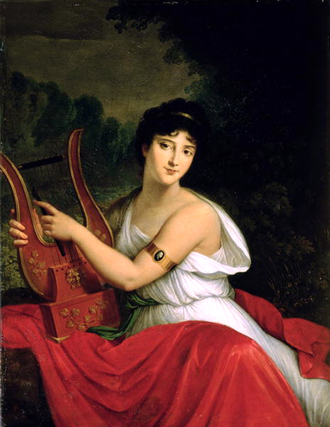 |
| Roberto I of Naples @Wikipedia |
(1276-1343)
King of Naples
1309-1343
Son of Carlo II di Napoli & Maria of Hungary.
 |
| Queen Sancha & King Robert of Naples @Wikipedia |
Husband of:
1. Violante de Aragon (1273-1302), Duchess of Calabria, mar 1297
Daughter of Pedro III de Aragon & Costanza di Sicilia
" . . . She married Robert of Naples, but was never Queen of Naples since she died before her husband inherited the throne." (Wikipedia)
 |
| Sancha of Mallorca Queen of Naples @Wikipedia |
2. Sancha de Mallorca (1285-1345), mar 1304
Queen consort of Naples, 1309-1343
Regent of Naples ("Queen Mother, Regent of the Kingdom and tutrix") for step-granddaughter Giovanna I, 1343-1344
Lady of Potenza, Venosa, Lanciano, Alessa & Sant'Angelo dei Lombardi, 1311 (gift from husband)
Daughter of Jaime II de Mallorca & Esclaramonde de Foix
His lover was:
1) Sibila Sabran
Lover in 1310?
Wife of Count Thomas IV of Aquino.
Natural offspring:
 |
| A Vision of Fiammetta by Dante Gabriel Rossetti @Wikipedia |
1. Maria d'Aquino (c1310-1382)
Wife of Andrea Thopia, Lord of Matija.
"Maria d'Aquino was a royal bastard, an illegitimate daughter of Robert the Wise, King of Naples and Count of Provence. She was an accomplice in the 1345 murder of King Andrew, the husband of her niece and Robert's successor, Queen Joanna I. For this Maria was sentenced to death and beheaded in 1382 on the orders of Queen Joanna I's successor, King Charles III." (Wikipedia)
" . . . She is traditionally identified as Fiammetta. According to him, Maria's mother was a Provençal noblewoman, Sibila Sabran, wife of Count Thomas IV of Aquino. She was born after Countess Sibila and King Robert committed adultery at his coronation festivities in 1310, but was given the family name of her mother's husband. Her putative father placed her in a convent." (Wikipedia)
"Poorly suited to the job, he switched to studying canon law, and finally to writing. Soon, he was mingling with the leading scholars of the day, gained access to the French court where French chivalry was still alive and flourishing, and fell in love with the illegitimate daughter of Robert the Wise, king of Naples and count of Provence, Maria d'Aquina, known by her sobriquet Fiammetta ('little flame'), who would dominate his early works, which included romances and poems in the French medieval style. . . ." (Italy A to Z)
"In 1336, the writer Giovanni Boccaccio (1313-1375) met his Fiammetta (Little Flame) at San Lorenzo Maggiore. So smitten was Boccaccio with Maria d'Aquino, illegitimate daughter of King Robert the Wise in Naples, that her vision inspired the character Fiammetta in Filocolo, L'Elegia di Madonna and, most famously, the Decameron. In Boccaccio's medieval masterpiece of a hundred tales Fiammetta is one of the wittiest of the 10 storytellers who have fled to the countryside to avoid a bubonic plague-ridden Florence." (Naples: Includes Pompeii, Vesuvius & Herculaneum: 37)
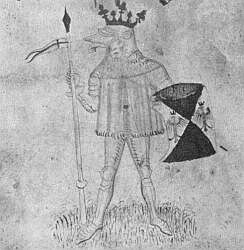 |
| Marti I of Sicily @Wikipedia |
Son of Martin I de Aragon & Maria de Luna
Husband of:
1. Maria di Sicilia, mar 1390/92
2. Blanca de Navarra, mar 1402
His lover was:
1) Tarsia Rizzani
Natural offspring:
a. Fadrique de Aragon (1400/03-1438), Conde de Luna, mar Violante Luisa de Mur.
Lover of: Roberto Orsini, 4th Conte di Nola (1360-1400)
2) Agatuzza de Pesci
Natural offspring:
a. Violante de Aragon (d.1428) a-1) mar in 1405 Enrique Perez de Guzman, 2nd Conde de Niebla (1371-1436) and a-2) Martin de Guzman.
" . . . Marti the Young did have two surviving illegitimate children, Fadrique and Violant, the result of liaisons with the Sicilian ladies, Tarsia Rizzani and Agatuzza de Pesci. In 1403, Marti I conveyed these two children to the Crown, where they were put in Maria's care and she took the role of educator and grandmother--legitimate or not, they represented the future of her line." (Earenfight: 88)
 |
Federigo III of Sicily |
Regent of Sicily
1291-1295
King of Sicily
1295-1337
King of Trinacria
1302.
Son of: Pedro III de Aragon & Costanza di Sicilia.
Husband of: Eleonore d'Anjou (1289-1341), mar 1302
His lovers were:
1) Sibilla di Sormella (1273-?)
Lover in 1291?-1302.
Catalan aristocrat.
Daughter of Siro di Solimelia & Ilagio di Santa Sofia
Natural offspring:
a.Alfonso Federico di Sicilia (c1294-1334/39), Conte di Malta e Gozzo, Signore di Salona, Regent of Duchy of Athens & Neopatria
Husband of: Marulla of Aegina, Lady of Aegina, mar 1317, daughter of Bonifacio da Verona, Signore di Negroponte.
b. Orlando di Sicilia (1296-1361), Barone di Avola
c. Elisabetta di Sicilia (1297-1341) mar Ponzio VI di Empuries Raimondo di Peralta, Conte di Caltabellotta
d. Eleonora di Sicilia (1298-?) mar Giovanni di Chiaramonte, Conte di Modica
5. Sancho di Sicilia (1300-1334), Barone di Militello, mar Macalda Palizzi, Signora di Cammarata.
"Although marriage negotiations had languished since his accession, Louis did leave two illegitimate sons, Antonio (Anthony) and Luigi (Louis), who were sent to Barcelona to be raised by their aunt Eleanor, queen of Aragon. . . ." (Wikipedia)
Natural offspring:
a. Antonio de Aragon (1350/55-?) mar Beatrice de Exerica
b. Luigi de Aragon (1350/55-1374), Barone di Tripi
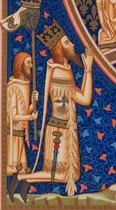 |
| Luigi I of Naples @Wikipedia |
Husband of Giovanna I di Napoli.
His lover was:
Unnamed mistress.
Natural offspring:
a. Esclabonde mar Luigi di Capua, Conte di Altavilla
b. Clemenzia mar Antoine, Seigneur de La Mendolee.
King of Sicily
1355-1377
Duke of Athens & Neopatras
1355-1377
Son of: Federigo III di Sicilia & Éléonore d'Anjou
Husband of:
His lover was:
Unnamed mistress.
Natural offspring:
a. Guglielmo de Aragon (d.1380), Conte di Gozzo e Malta.
His lover was:
Daughter of a doctor of Perugia.
Natural offspring:
a. Rinaldo di Durazzo, Titular Prince of Capua, Married & with descendants
b. Maria di Durazzo
"About a hundred years later we find a curious tale dealing with the death of King Ladislao . . . of Naples. He aspired to absolute rule of Italy, but, according to one version, was mysteriously poisoned by a trick of the Florentines in 1414. The story goes that they bribed a certain unscrupulous doctor of Perugia, whose beautiful daughter was the mistress of Ladislao. The unnatural father persuaded the girl that if she wanted to be loved exclusively and unceasingly by her royal lover she must secretly rub herself with a certain ointment which he himself had prepared for her. The deluded girl believed him and did his bidding, used the ointment, which was composed chiefly of the juice of aconite (monk's-hood), and both she and the king lost their lives." (Poison Damsels: 67)
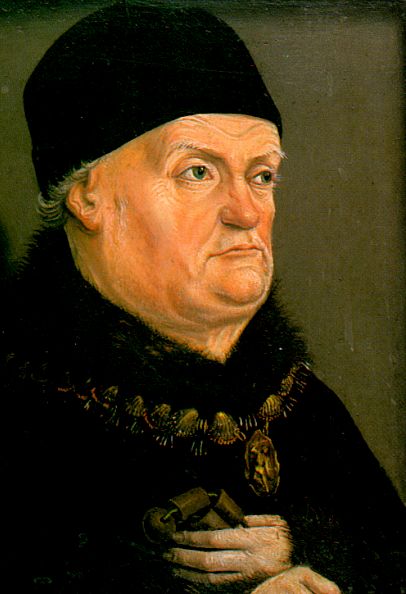 |
| Renato I of Naples |
(1409-1480)
King of Naples
1435-1480
Duc d'Anjou 1434
Duc de Bar 1430
Duca di Calabria
Duc de Lorraine 1431
Comte de Provence 1434
Comte de Piedmont 1430
Comte de Guise
Husband of:
1. Isabelle de Lorraine (d.1453), mar 1420, daughter of Charles II de Lorraine & Margarethe von Bayern
His lover was:
Catherine d'Albertas.
Natural Offspring:
a. Jeanne-Blanche d'Anjou.
b. Magdeleine d'Anjou.
References:
Bio2:Trionfi] [Bio3:Craigsweb] [Bio4:Quintessential Publications] [Fam1:Dinastias] [Ref1:Lost Saints] [Ref2:Dictionary.com] [Ref3:Guice]
Re di Napoli
1458-1494
Husband of:
1. Isabella di Chairomonte, Signora di Taranto (1424-1465), mar 1444
2. Juana de Aragon (1454-1517), mar 1476
His lovers were:
1) Diana Guardato (1425-?)
Daughter of Zaccaria Guardato, adviser & lieutenant of the Great Chancellor of Naples.
Natural offspring:
a. Maria d'Aragona (1440-1460), mar 1458 Antonio Todeschini Piccolomini (1437-1493) 1st Duca di Amalfi , 1461-1493)
b. Giovanna d'Aragona (1455-1501), mar 1474 Leonardo della Rovere (1445-1475), Duca di Sora
c. Fernando d'Aragona (1460-1542), 1st Duca di Montalto
2) Eulalia Ravignano.
3) Giovanna Caracciolo.
Natural offspring:
a. Enrico d'Aragona, Marchese de Gerace (?-1478), a.k.a. Arrigo d'Aragona, mar Polissena de Ventimiglia
a.1. Caterina d'Aragona
a.2. Luigi d'Aragona, Cardinal
a.3. Giovanna d'Aragona, Duchesa d'Amalfi
a.4. Carlo d'Aragona
b. Alfonso d'Aragona (d.1510)
c. Cesare d'Aragona, Marchese de Sant'Agata (d.1501)
4) Lucia Migliaccio, Duchesa di Floridia.
5) Trogia Gazzela.
References:
 |
| Alfonso II of Naples @Wikipedia |
(1448-1495)
King of Naples
1494-1495
Husband of Ippolita Maria Sforza, mar 1465
His lover was:
Troggia Gazzela (1460-1511).
Natural offspring:
a. Sancha de Aragon (1478-?)
b. Alfonso de Aragon (1481-1500), Duca di Bisceglio, Principi di Salerno. [Fam1:GeneaNet] [Ref1:Wikipedia]
 |
| Ferdinando II of Naples @Wikipedia |
(1469-1496)
Husband of Giovanna di Napoli (1478-1518), mar 1496
 |
| Ferdinando I of the Two Sicilies @Wikipedia |
(1751-1821)
King of the Two Sicilies
1816-1825
Ferdinando IV di Napoli
1759-1816
Ferdinando III di Sicilie
1759-1816
 |
| Maria Carolina of Austria Queen of the Two Sicilies @Wikipedia |
1. Maria Karolina von Österreich (1752-1814), mar 1768
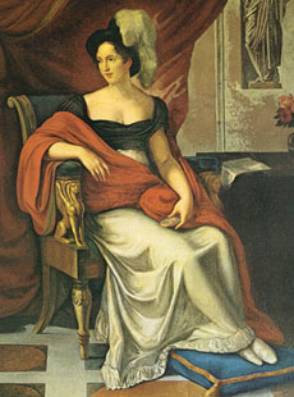 |
| Lucia Migliaccio @Wikipedia |
2. Lucia Migliaccio (1770-1826), mar 1814
" . . . When his father ascended the Spanish throne in 175 9 Ferdinand, in accordance with the treaties forbidding the union of the two crowns, succeeded him as king of Naples, under a regency presided over by the Tuscan Bernardo Tanucci. The latter, an able, ambitious man, wishing to keep the government as much as possible in his own hands, purposely neglected the young king's education, and encouraged him in his love of pleasure, his idleness and his excessive devotion to outdoor sports. Ferdinand grew up athletic, but ignorant, ill-bred, addicted to the lowest amusements; he delighted in the company of the lazzaroni (the most degraded class of the Neapolitan people), whose dialect and habits he affected, and he even sold fish in the market, haggling over the price. . . ." (Theodora)
His lover was:
Bretella.
Metternich's " . . . first wife died in 1825; and shortly after, the prince married a second time. The bride was Antonia von Leykam, daughter of a younger son of a family of postal upstarts, who had risen in the service of Prince Taxis. Her mother was a woman of very bad character, a singer and opera dancer named Bretella. She had been for some time the mistress of the Lazzaroni king Ferdinand IV of Naples; after which she married Baron Ambrosius Leykam. Antonia, the second daughter of this couple was born in 1806; and her delicate beauty was universally acknowledged and admired. The marriage created an immense sensation in the high world of Vienna. . . ." (Memoirs of the Court, Aristocracy, and Diplomacy of Austria, Vol 2: 434)
 |
| Joachim Murat of Naples @Flickr |
(1767-1815)
King of Naples & Two Sicilies
1808-1815
Regent of Spain 1808
Prince of the French Empire 1805
1st Prince Murat 1806
Grand Duke of Berg & Cleves 1806-1808
Grand Admiral of France 1805
Marshal of France 1804
Governor of Paris 1802
“The martial air of that Monarch, the magnificence of his uniform, his reputations, and the novelty of such an action made his influence over these savages seem true.… For such was Murat: a stage King in the studied elegance of his attire, a real King in his bravery and inexhaustible activity, equal to any attack and always armed with an air of superiority and menacing assurance—the most dangerous of all offensive weapons.” (Warfare History Network)
Son of Pierre Murat-Jordy, an innkeeper & postmaster & Jeanne Loubières
Joachim's personal & family background.
"Joachim Murat was born March 25, 1767 in the village of La Bastide-Fortunière in Gascony. He was the 11th and last child of innkeepers Pierre and Jeanne Murat. Through the influence of Talleyrand’s family, young Joachim was sent to a seminary. However, the 'Abbé Murat' loved horses and since childhood he could ride like a young Bedouin. When a regiment of chasseurs appeared at Toulouse, the adventurous lad joined them. In April 1793 he was a captain; by May, a major." (Warfare History Network)h
"The son of an innkeeper in Cahors, Gascony, Murat possessed all the characteristics of the Gascon and never outgrew a single one of them, not even as a king. As a lad he was brash, impudent, vain, daring, gallant and utterly unreliable. As a man who was to go down in history as the most spectacular handler of cavalry since Rupert of the Rhine he remained all these things, up to the very moment of death." (The March of the Twenty-Six)
Husband of Caroline Bonaparte, mar 1800.
"When Napoleon, blindly imagining that his army could successfully contend with the severity of a northern winter, formed tha gigantic project of subjugating Russia, Murat was summoned from the Neapolitan throne to Dresden, to take the command of the cavalry of the Imperial army. Previous to his departure, Murat, who had married Napoleon's sister, Caroline Bonaparte, established a regency, at the head of which he placed his queen. This lady, though not the handsomest, was certainly the most interesting and best-informed of all Napoleon's sisters. Besides many feminine accomplishments, she possessed great personal courage and tact in the management of political and administrative affairs. Unfortunately, however, she was, like her eldest brother, inclined to be despotic---a disposition which manifested itself as soon as the regency of the kingdom fell chiefly into her hands. This was unfortunate: for, under the mildest rule of a foreign power, a conquered nation seldom sits quietly; and the Neapolitans already bore with impatience the sway of a French king. Caroline's arbitrary character was known, and on Murat's departure, the discontent of the Neapolitans increased; they redoubled their efforts to overthrow the French dynasty, and to re-establish the exiled Bourbons on the throne." (Chambers's Journal: 23)
"By April 1797, the Austrians had been driven back to Leoben and forced to request an armistice. Bonaparte paid a visit to his family at the castle of Mombello near Milan, accompanied by his brilliant cavalry commander. From the moment she met him, Napoleon’s sister, Caroline Bonaparte, then a beautiful 15-year-old girl, fell in love with the 30-year-old cavalryman. His robust six-foot form, adorned with a gold-braided jacket and skin-tight cavalry breeches, as well as his dark Gascon features, blue eyes, long mane of jet-black hair, and sensuous lips were enough to make any girl swoon. Caroline Bonaparte was excited by the towering man who kissed her hand; he, in turn, was seduced by her beauty. The love they shared would last all their lives."(Warfare History Network)
Murat's spouse & children.
" . . . The First Consul rewarded him amply, appointing him inspector of the consular Guard, and, later, still, in preference to his rival, Lannes, gave him in marriage his sister Caroline. Murat had met Caroline Bonaparte at Montebello during the Italian campaign of 1896, and had at once been struck by her beauty. Like many another cavalier, he had a flame in every country, or rather, in every town which he visited. But by 1799 the gay Gascon saw that it was time to finish sowing his wild oats, since destiny was offering him a change which falls to the lot of few mortals. It was by now clear that the First Consul's star was in the ascendant. Already his family were reaping the fruits of his success. Ambition, pride and love were the cords of the net which drew the willing Murat to Caroline. As brother-in-law to the First Consul, Joachim felt secure against his bitter rival, Lannes. To add point to this success, he knew that the victor of Montebello was straining every nerve to gain this very prize. Moreover, Fortune herself favoured his suit. Bonaparte had offered the hand of Caroline to the great General Moreau, but the future victor of Hohenlinden refused to join himself to the Corsican triumph. To cover his confusion the First Consul was glad to give his sister's hand to one of his most gallant officers, especially as by doing so he once and for all removed the haunting fear of an intrigue between him and Josephine. Accordingly, on January 25, 1800, Murat and Caroline were pronounced man and wife in the temple of the canton of Plailly, by the president of the canton. Though Caroline only brought with her a dot of forty thousand francs, she stood for what was better still, immense possibilities." (Napoleon's Marshals: 28)
 | |
Joachim Murat
|
Murat's physical appearance & personal qualities.
" . . . Dr. Holland describes him as a tall and masculine person, with handsome features which exuded good nature and 'a rude energy and consciousness of physical power.' His black curly hair tumbled over his shoulders, and he wore a hat which was 'gorgeous with plumes.' He was also a man of strong passions, a spirited child of the revolution, and was splendidly courageous. . . ." (The Trial of Queen Caroline: 59)
" . . . Having seen no service, he owed his appointment largely to his conceit and good looks. Blue-eyed, with an aquiline nose and smiling lips; with long chestnut curls falling his well-poised head; endowed with great physical strength, shown in his strong, supple arms and in the long flat-thighed legs of a horseman, he appeared the most perfect type of the dare-devil, dashing cavalry soldier. . . ." (Napoleon's Marshals: 21)
Mounted on a horse like someone who had galloped out of fourteenth-century romance.
"Destined for the church he wrecked his father's plans by running off at the age of twenty and enlisting in the Mounted Chasseurs. That was two years before the Revolution and when cavalry was in demand Murat was prancing and sabre-flourishing with such gusto that his fellow Chasseurs decided he would either be dead or in command of the regiment before the year was out. There was something about this handsome young man that made a deep impression on everybody. His self-display was carried to such lengths that he was early recognised as a buffoon, but there was nothing ridiculous about him when it came to handling a mettlesome horse or thundering down on an unbroken square of infantry. You might laugh at him and call him a cross between a peacock and a mountebank but you had to admire him in action. Mounted on a horse that few men could manage, with his coal-black hair streaming in the wind, he looked and behaved like someone who had galloped out of fourteenth-century romance. For a long time, notwithstanding his looks and courage, his theatricality held him back, but when at last his chance presented itself he exploded like a display of fireworks. D'Artagnan may have put the word Gasconnade into the dictionary but Murat has kept it there ever since." (The March of the Twenty-Six)
"Joachim Murat, if not the best-informed man, was undoubtedly the most gallant and intrepid soldier in the Imperial army of France. Having risen from the ranks to the high station of general, every part of a soldier's duty was familiar to him, and in all the details of the military art he had no rival. Napoleon designated him the best cavalry officer in Europe. His person was as manly as his manners were effeminate---his noble features and powerful limbs contrasting strangely with the eccentric frivolity of some of his actions. His best characteristics were, however, a strong natural sagacity, and an almost unbounded generosity both in public and private life. There qualities were frequently called forth when he was placed by Bonaparte on the throne of Naples." (Chambers's Journal: 22)
An original character.
"Napoleon once remarked, 'Murat possessed quite an original character.… By my side he was always my right hand. When I ordered him to overthrow a force of some 4,000 to 5,000 men in a given direction it was for him the work of a moment.… He was brave in the presence of the enemy, in that case perhaps the bravest man in the world. His impetuous courage carried him into the midst of danger. And then he was decked out in gold and feathers that rose above his head like a church tower. He escaped continually as by a miracle, for he was easily recognized by his dress. He was a regular target for the enemy, and the Cossacks used to admire him on account of his astonishing bravery.'" (Warfare History Network)
Le Beau Sabreur's legacy.
"Caroline, the scheming, sensuous woman to whom Murat owed so many of his failures, soon found another husband and shrugged off the memory of the gallant ass who had sent hussars galloping off to her school to guard her during the touch-and-go hours of the Great Coup in 1799 but France did not forget him so readily. Silly, untrustworthy abd vain as a peacock, he was also the most dashing horseman a nation of soldiers has ever produced. When we think of him not it is not as a bombastic, overdressed egoist, strutting among his yes-men at Naples but as a gay young hussar with bulging thigh muscles, dashing across the snow at the head of eighty squadrons of cavalry and waving a gold want instead of a saber." (The March of the Twenty-Six)
 |
| Joachim Murat |
His lovers were:
1) Contessa Gerardi.
Sister of General Lecchi.
". . . (I)n 1797 . . . Bonaparte sent (Murat) from Italy to Switzerland, to select headquarters for him, and thence to Paris with the text of the treaty of Campo Formio. Murat, upon that errand did not go alone. He took with him the beautiful Countess Gerardi, whom he had met at Brescia, and who had left her home and her husband to accompany him. Her husband followed, and made representations to the Directoire. . . . " (Papers Past)
" . . . Other gossip pointed to the Countess Gerardi, a sister of the Italian general Lechi, said to have been then the most beautiful woman in Lombardy." (Joachim Murat: Marshal of France and King of Naples: 34)
2) Eleonore Denuelle de la Plaigne (1787-1868)French royal mistress.
" . . . She was the daughter of shady adventurer parents and found a niche as personal secretary to the Murats. Later an absurd story was concocted that Murat had raped her, but the truth was that she became his lover willingly enough. The cynical Caroline was unmoved by this but saw potential in Eleonore as a real threat to Josephine." (Napoleon: A Biography)
3) Juliette Bernard (1777-1849)
"Joachim Murat, Napoleon’s brother-in-law, is King of Naples from 1808 to 1815. Murat is tall and masculine, with handsome features and black curly hair that tumbles over his shoulders. As he prefers to dress in a flamboyant style, his nickname is 'The Dandy King'”. He is also famous for his courage and his strong passions. It is rumoured that Caroline, the Princess of Wales (wife of ‘Prinny’), becomes his lover when she visits Naples in 1814. Is it gossip or truth? Fact is that, when Caroline first arrived at Naples, Murat meets her outside the city and accompanies her to her residence. Additionally, he stations a royal guard at her residence for protection and as sign of honour. Moreover, Murat and Caroline are often seen driving around together in Murat’s carriage." (Regency Explorer)
5) Madame Ruga.
Wife of a local lawyer.
" . . . Desaix, in his journal of the campaign of 1797, noted that the attraction for Murat at Brescia was a certain Madame Ruga, the wife of a local lawyer. . . ." (Joachim Murat: 33)
References:
.jpg)


